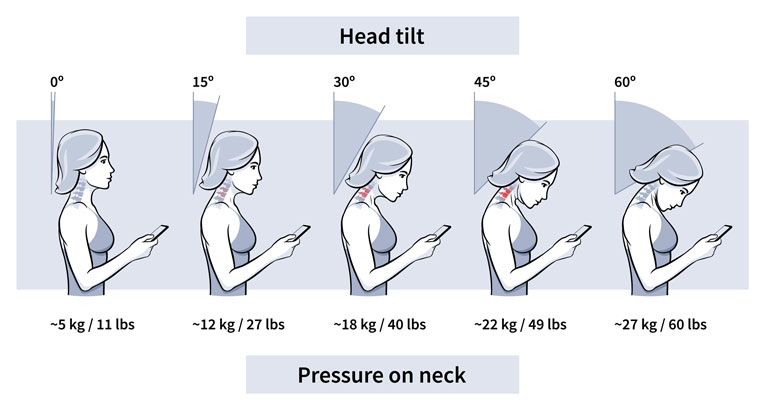We are spending more time looking at screens than ever, whether working on a computer or texting on our phones. And all that time adds up. According to a report in People magazine,
the average American could spend up to 44 years of their lifetime staring at TVs, laptops, and cell phone screens.
All this screen time can affect your vision, your mental health and your spine.
Jared Crasto, MD, spine surgeon with The Christ Hospital Physicians, says the way we look at our screens can have a huge effect on the health of our necks.
Typical screen time posture leads to neck pain
When you look at your computer screen, you tend to adopt a "forward head posture." Without thinking about it, you likely push your head toward the screen to read more clearly. That means you flex the muscles lower down in your neck and extend the muscles in the upper part of your neck.
When you look at a phone, your head likely hangs down with your entire neck flexed. You may even have your chin almost on your chest. Unfortunately, both postures move your neck into inefficient positions.
"Your muscles, ligaments and tendons all function at maximal efficiency in certain postures," says Dr. Crasto. "That's why there is so much research around ergonomics and setting up your desk."
Dr. Crasto says that when you are in an inefficient posture, your muscles get tired much more quickly. And it's no wonder why.
"When you look straight ahead with your spine neutrally-aligned, your neck muscles maintain about 10 – 12 pounds of force to support your head," says Dr. Crasto. "When you look down slightly, say at a 15-degree angle, that increases to 27 pounds of weight on your muscles. At 60 degrees, which is how most people look at their phones, your neck muscles have to support 60 pounds of force."

The long-term risks of poor screen time posture
If you hold your neck in these awkward positions for long periods of time, your muscles begin to wear out faster and faster. They can't perform their job as well, putting more pressure on other structures in your neck like your ligaments, tendons and joints.
Dr. Crasto says this wear and tear can lead to conditions such as:
These postures can even begin to affect your mental health.
"When you are looking down at your phone, your shoulders hunch forward as well," says Dr. Crasto. "That means you breathe in much less as well. You take shorter, shallower breaths and this can actually make you feel anxious."
What can you do to reduce your risk of neck pain from technology?
The key to protecting your neck from long-term problems is using good ergonomics whenever you use your computer or phone. The screen should be at eye level. For example, you might need to raise your computer, raise your chair or purchase some products to support your spine.
When using a computer, Dr. Crasto recommends this posture:
Sit with your knees bent at a 90-degree angle
Place your feet flat on the floor. If your feet won't fully reach the ground, use a small footrest to take the pressure off your hamstrings.
Set your eyes and head level with the top of your computer screen
Support your lower back with a cushion or pillow on your chair or choose a desk chair that offers built-in lumbar support.
In this posture, you only need to move your eyes, not your head, to see the screen. This position relieves a lot of pressure on your neck, keeping those muscles healthy.
Maintaining proper phone posture can be harder. People often consider it rude or strange to keep your phone at eye level. But you can still do things to protect your neck.
"It's best to use your phone when you are either seated or standing still," says Dr. Crasto. "You tend to have worse posture when you move and use your phone. You should also text with two hands. When you text with one hand, you tend to tilt your neck toward your phone, so that can increase neck tension."
Overall, he says the best texting position is seated with your elbows on the table and your phone at eye level.
Stretches and movements can protect your neck, too
Dr. Crasto also says you need to stretch your neck muscles every 30 or 40 minutes. These little breaks can reenergize and reactivate your muscles, helping protect your ligaments and joints.
He suggests exercises such as:
- Stretching your neck from side-to-side and forward-to-back, holding the stretch for 10 to 30 seconds per side
- Rolling your shoulders forward and backward
- Reaching your arms above your head and from side-to-side
- Getting up and walking around for a few minutes
When should you see a doctor about neck pain?
If you find yourself with frequent neck or head pain, it might benefit you to see a spine surgeon like Dr. Crasto. You should watch out for symptoms like;
- Recurring tension headaches that start in the back of your skull and creep around to the top of your head
- Jaw pain or popping
- Neck pain when not using technology
- Neck stiffness
- Pain that shoots down one or both arms
- Numbness or tingling in one or both arms
Don't let neck pain disrupt your life.
Learn more about the spine care at The Christ Hospital. We can help you improve your neck health and your quality of life.